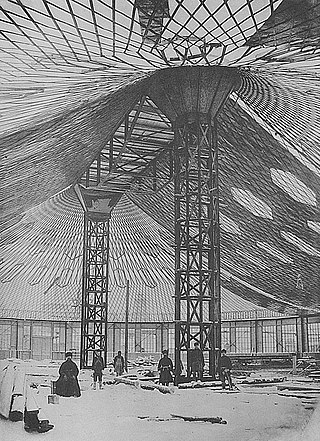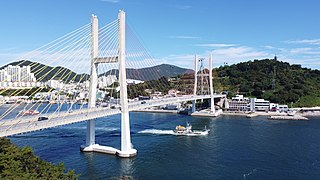Related Research Articles

Reinforced concrete (RC), also called reinforced cement concrete (RCC) and ferroconcrete, is a composite material in which concrete's relatively low tensile strength and ductility are compensated for by the inclusion of reinforcement having higher tensile strength or ductility. The reinforcement is usually, though not necessarily, steel bars (rebar) and is usually embedded passively in the concrete before the concrete sets. However, post-tensioning is also employed as a technique to reinforce the concrete. In terms of volume used annually, it is one of the most common engineering materials. In corrosion engineering terms, when designed correctly, the alkalinity of the concrete protects the steel rebar from corrosion.

Rebar, known when massed as reinforcing steel or reinforcement steel, is a steel bar used as a tension device in reinforced concrete and reinforced masonry structures to strengthen and aid the concrete under tension. Concrete is strong under compression, but has weak tensile strength. Rebar significantly increases the tensile strength of the structure. Rebar's surface features a continuous series of ribs, lugs or indentations to promote a better bond with the concrete and reduce the risk of slippage.

A beam is a structural element that primarily resists loads applied laterally to the beam's axis. Its mode of deflection is primarily by bending. The loads applied to the beam result in reaction forces at the beam's support points. The total effect of all the forces acting on the beam is to produce shear forces and bending moments within the beams, that in turn induce internal stresses, strains and deflections of the beam. Beams are characterized by their manner of support, profile, equilibrium conditions, length, and their material.

Prestressed concrete is a form of concrete used in construction. It is substantially "prestressed" (compressed) during production, in a manner that strengthens it against tensile forces which will exist when in service.

A tensile structure is a construction of elements carrying only tension and no compression or bending. The term tensile should not be confused with tensegrity, which is a structural form with both tension and compression elements. Tensile structures are the most common type of thin-shell structures.

The eastern span replacement of the San Francisco–Oakland Bay Bridge was a construction project to replace a seismically unsound portion of the Bay Bridge with a new self-anchored suspension bridge (SAS) and a pair of viaducts. The bridge is in the U.S. state of California and crosses the San Francisco Bay between Yerba Buena Island and Oakland. The span replacement took place between 2002 and 2013, and is the most expensive public works project in California history, with a final price tag of $6.5 billion, a 2,500% cost overrun from the original estimate of $250 million. Originally scheduled to open in 2007, several problems delayed the opening until September 2, 2013. With a width of 258.33 ft (78.74 m), comprising 10 general-purpose lanes, it is the world's widest bridge according to Guinness World Records.

Wire rope is several strands of metal wire twisted into a helix forming a composite rope, in a pattern known as laid rope. Larger diameter wire rope consists of multiple strands of such laid rope in a pattern known as cable laid.
This is an alphabetical list of articles pertaining specifically to structural engineering. For a broad overview of engineering, please see List of engineering topics. For biographies please see List of engineers.

Anchor bolts are used to connect structural and non-structural elements to concrete. The connection can be made by a variety of different components: anchor bolts, steel plates, or stiffeners. Anchor bolts transfer different types of load: tension forces and shear forces.

The King Street Bridge carries King Street over the Yarra River in Melbourne, Australia. The bridge continues south as an elevated viaduct, with the Crown Casino built around it in later years.

In structural engineering, a prestressed structure is a load-bearing structure whose overall integrity, stability and security depend, primarily, on prestressing: the intentional creation of permanent stresses in the structure for the purpose of improving its performance under various service conditions.

Structural engineering depends on the knowledge of materials and their properties, in order to understand how different materials resist and support loads.
In the Eurocode series of European standards (EN) related to construction, Eurocode 2: Design of concrete structures specifies technical rules for the design of concrete, reinforced concrete and prestressed concrete structures, using the limit state design philosophy. It was approved by the European Committee for Standardization (CEN) on 16 April 2004 to enable designers across Europe to practice in any country that adopts the code.
The Post-Tensioning Institute (PTI) is a not-for-profit trade association committed to advancing the quality, safety, efficiency, profitability, and use of post-tensioning systems. PTI's manuals and technical guides provide guidance on the design, construction, maintenance, and repair/rehabilitation of post-tensioned concrete structures. Additionally, PTI aims to ensure that specifiers and purchasers of post-tensioning materials receive products and services that meet a standard of quality through its plant and field personnel certification programs. Members of the Institute include major post-tensioning companies, as well as more than 500 professional members, engineers, architects, and contractors from around the globe.
Barrier cable is a vehicular or pedestrian restraint system used in parking garages. It installed along the ramps or around the perimeter of the parking structure. It consists of a 0.5-inch, 7-wire steel strand which is similar to the strand used in Post-tensioned concrete.
Reinforced concrete [RC] is concrete in which reinforcement bars ("rebars"), reinforcement grids, plates or fibers are embedded to create bond and thus to strengthen the concrete in tension. The composite material was invented by French gardener Joseph Monier in 1849 and patented in 1867.

The Geobukseon Bridge (Korean: 거북선대교), also called the Second Dolsan Bridge (Korean: 제2돌산대교), is the main bridge on the Yeosu Road between Udu-ri, Dolsan and Jonghwa-dong, linking the Port of Yeosu with Dolsando across the Namhae sea. The bridge is floating cable-stayed bridge with 464m (35+82+230+82+35m) length and its construction started in June 2008. It opened in April 2012 and carries four lanes of motor vehicle traffic. The new link was intended to reduce traffic congestion on the First Dolsan Bridge which opened in 1985, and act as an important infra-structure link during the Yeosu Expo which had been held from May, 2012 for three months. The bridge was built by contractor Daelim Industrial Co. Ltd for client Iksan Regional Construction & Management Administration. Contract cost is US$60million, which includes a 460m long tunnel at one end, and a 280m long approach bridge.
This glossary of structural engineering terms pertains specifically to structural engineering and its sub-disciplines. Please see glossary of engineering for a broad overview of the major concepts of engineering.
PC Strand, or prestressed concrete steel strand, is a twisted steel cable composed of 2, 3, 7 or 19 high strength steel wires and is stress-relieved (stabilized) for prestressed concrete or similar purposes.
The reinforcement of 3D printed concrete is a mechanism where the ductility and tensile strength of printed concrete are improved using various reinforcing techniques, including reinforcing bars, meshes, fibers, or cables. The reinforcement of 3D printed concrete is important for the large-scale use of the new technology, like in the case of ordinary concrete. With a multitude of additive manufacturing application in the concrete construction industry—specifically the use of additively constructed concrete in the manufacture of structural concrete elements—the reinforcement and anchorage technologies vary significantly. Even for non-structural elements, the use of non-structural reinforcement such as fiber reinforcement is not uncommon. The lack of formwork in most 3D printed concrete makes the installation of reinforcement complicated. Early phases of research in concrete 3D printing primarily focused on developing the material technologies of the cementitious/concrete mixes. These causes combined with the non-existence of codal provisions on reinforcement and anchorage for printed elements speak for the limited awareness and the usage of the various reinforcement techniques in additive manufacturing. The material extrusion-based printing of concrete is currently favorable both in terms of availability of technology and of the cost-effectiveness. Therefore, most of the reinforcement techniques developed or currently under development are suitable to the extrusion-based 3D printing technology.
References
- 1 2 3 4 5 6 7 8 9 10 11 12 13 14 15 16 17 18 19 20 21 22 23 24 25 26 27 28 29 30 American Concrete Institute. "CT-13: ACI Concrete Terminology". American Concrete Institute. Farmington Hills, Michigan US: ACI. Retrieved 13 September 2016.
- 1 2 3 4 5 6 7 8 9 10 11 12 13 PTI Technical Advisory Board (November 2013). "TAB.3-13 Post-Tensioning Terminology" (PDF). Post-Tensioning Institute. Retrieved 14 September 2016.
- 1 2 3 4 5 6 7 8 9 10 11 12 13 14 15 16 17 18 19 20 21 Federation Internationale du Beton (Feb 2005). fib Bulletin 31: Post-tensioning in Buildings (PDF). FIB. ISBN 978-2-88394-071-0. Archived from the original (PDF) on 8 February 2017. Retrieved 26 August 2016.
- 1 2 3 4 5 6 7 8 9 10 Lin, T.Y.; Burns, Ned H. (1981). Design of Prestressed Concrete Structures (Third ed.). New York, US: John Wiley & Sons. ISBN 0-471-01898-8. Archived from the original on 2017-02-08. Retrieved 2016-09-16.
- ↑ Cross, Ed. "CIA Seminar - Post-Tensioning in Building Structures" (PDF). www.ptia.org.au. Post Tensioning Institute of Australia. Retrieved 16 September 2016.
- 1 2 3 PTIA. "Slab System Concrete Requirements for Early Age Stressing" (PDF). www.ptia.org.au. Post Tensioning Institute of Australia. Retrieved 16 September 2016.
- ↑ "BridgeTalk Discussion Forum" . Retrieved 14 September 2016.